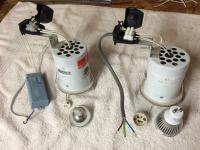Hi
I have 25 MR16 Aurora fire-rated downlights like these in a few downstairs rooms, installed by an electrician during building work 5 years ago. All wired via small black JBs and Aurora transformers.
I'm converting them all from 50W halogens to 5W LEDs. I've had some false starts with MR16 LEDs (existing transformers causing LEDs to fail) so I've decided to remove the transformers and convert them all to GU10 - new flex from JB to fitting, then new GU10 bulb holder.
The current fittings aren't earthed and aren't marked as double insulated as far as I can see). Should they be earthed now that they will be mains voltage? If so, how - is there some kind of mini earth clamp I could use? The fitting wiring is in a standard small black plastic box completely isolated from the metal fitting. I know I could replace the fitting entirely, but that would make the job more expensive than it's worth.
Cheers
I have 25 MR16 Aurora fire-rated downlights like these in a few downstairs rooms, installed by an electrician during building work 5 years ago. All wired via small black JBs and Aurora transformers.
I'm converting them all from 50W halogens to 5W LEDs. I've had some false starts with MR16 LEDs (existing transformers causing LEDs to fail) so I've decided to remove the transformers and convert them all to GU10 - new flex from JB to fitting, then new GU10 bulb holder.
The current fittings aren't earthed and aren't marked as double insulated as far as I can see). Should they be earthed now that they will be mains voltage? If so, how - is there some kind of mini earth clamp I could use? The fitting wiring is in a standard small black plastic box completely isolated from the metal fitting. I know I could replace the fitting entirely, but that would make the job more expensive than it's worth.
Cheers


